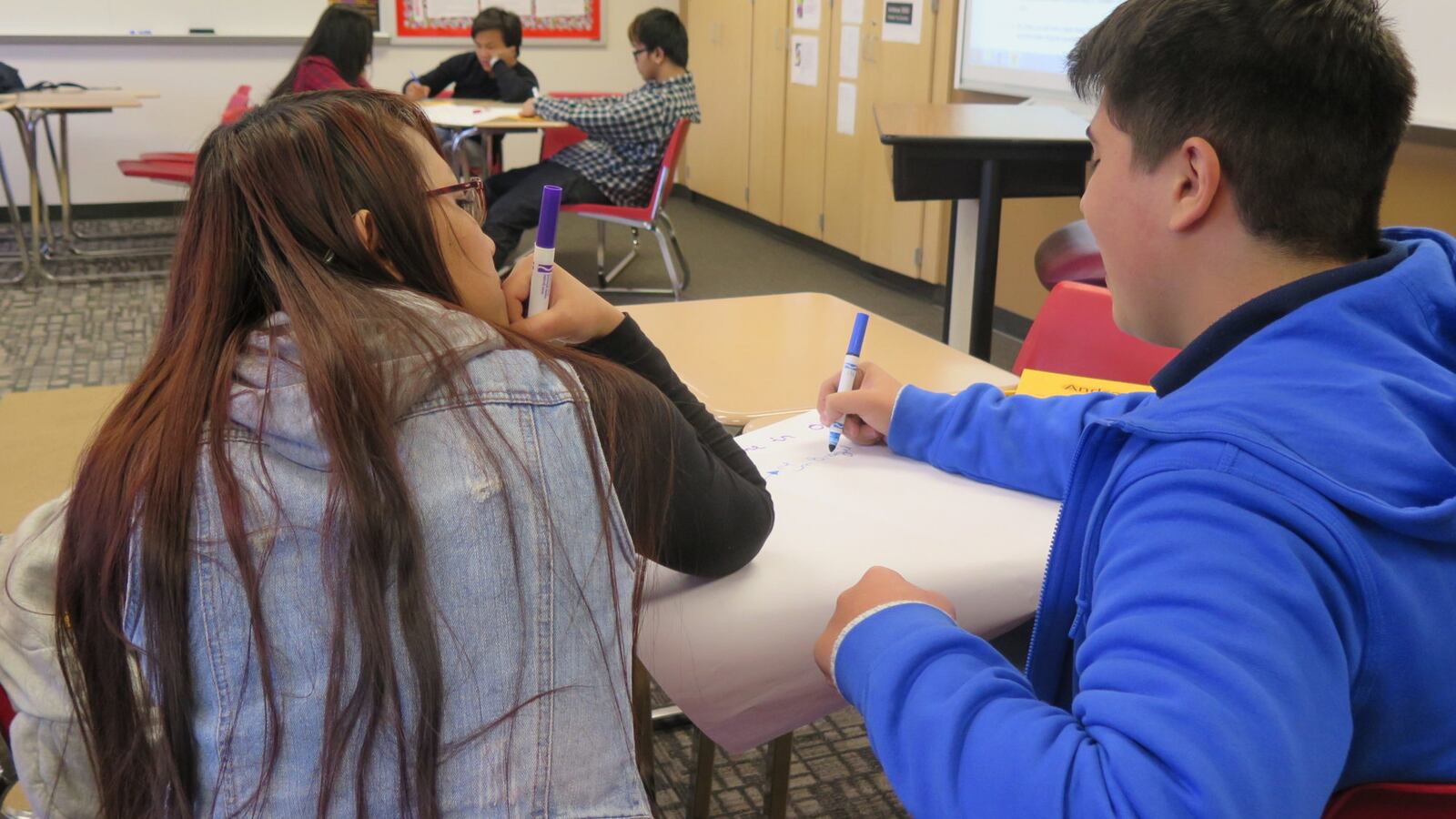
Kenny walked into my class at my Brooklyn high school on the first day of school, soon after celebrating his 18th birthday. Like too many other African-American teens in New York City, he had already dropped out of high school — twice. Transferring yet again, Kenny arrived on this cool September morning in a pressed shirt and tie, determined, it appeared, to make a fresh start.
Amal, already in her seat, watched Kenny as he walked into the classroom. She adjusted her hijab and returned to the “Do Now” assignment I had posted on the board: On an index card, write your name, age, where you are from, something you enjoy learning about, and your favorite thing about school. Later, I would learn that Amal, a refugee from Yemen, had recently immigrated to Brooklyn, was a newcomer to American schools, and enjoyed learning English.
Eighteen students started my combined English and English as a New Language class that day. Some were native speakers of English, while others, multilingual learners. The students spoke nine different home languages. Nearly all had experienced poverty, whether in Africa, the Caribbean, South America, or East New York, Brooklyn.
The diversity of this classroom was exciting and full of learning opportunities, but it also presented a number of challenges: How do we establish a community of learners out of this linguistically and culturally diverse group? What common materials and curriculum could possibly be relevant to all these students? And what might a culturally relevant approach look like for students from so many diverse cultures?
I am thinking about this particular class, which I taught in 2011, right now because of New York’s renewed focus on culturally relevant instruction. What we discovered together at the time — “problem-based learning” that truly values each students’ agency and personal contributions toward solving a common goal — could help teachers across the city as they strive to square the new priority with their existing practices.
I had taught linguistically, culturally, and academically diverse students for five years, and that year, I was determined to try a new approach that turned the “problem” on its head. At the start of the second day of class, each student found an envelope with her name on it waiting on her desk. Inside was a letter that invited students to take the lead on creating an ethnography of their community. Students read the letter — the first text they encountered in the class — in English, Spanish, or French. Some students were not literate in any language so were paired with a classmate. A few students were excited right away, while others were confused. “I don’t get it,” I heard. “What are we doing?”
That question informed the rest of the period. By the end of class, students were working in small groups to determine exactly what the letter was asking, and how they should respond — all core demands of project-based learning.
Problem-based learning allows students to engage in learning with more autonomy than traditional teaching does by building on individual needs, interests, and proclivities. In a problem-based environment the teacher typically does less talking and spends more time facilitating. This requires a close knowledge of both the content being explored as well as knowledge of students’ backgrounds, experiences, and strengths — a central requirement of culturally responsive teaching.
The ethnography task encouraged students to leverage their personal experience and expertise while becoming researchers and authors with a common intellectual goal. For multilingual learners, this was especially helpful as it enabled them to build language by connecting concepts and vocabulary to their personal experiences and identity. Students’ culture emerged as an inherently valuable and rich academic topic of which students already had prior knowledge.
During the next class, we considered students’ questions, starting with “What is an ethnography?” For students accustomed to being told what to do, the open-endedness was difficult. There were moments of uncertainty and silence, and questions arose: “Can we take pictures of the building?” “How are we supposed to find out about other kids in the school?” Instead of answering questions directly, I gave them space to shape the work and encouraged them to refer back to the invitation letter and the ethnography definition for guidance.
I felt comfortable leaving decisions up to my students because I knew there would be plenty of opportunities to read and write throughout the project. Indeed, by the end of the period, students had decided to respond to the invitation with a letter describing their work plan and brainstormed many of the roles and research methods that our ethnography would entail.
This prepared us for the following class, the usually dreadful business letter-writing. Over the next few days, students drafted, edited and published a letter. They also defined and chose roles: data collector, statistician, interviewer, photographer, editor, and, an important last-minute addition: web designer. This role, which I had not initially planned for, was a result of Kenny’s crucial insight into the problem of creating an authentic and useful ethnography for our school, “Does anybody read encyclopedias these days? Why don’t we make a website so we can share it with the school and use it for New Student Orientation?” No one could argue with this idea, so a few interested students selected web designer as one of their roles. Successful problem-based learning requires the teacher to stick to the learning plan while adapting to new and authentic solutions, such as Kenny’s website, which reshaped the project for subsequent years.
I had never before seen so many teens individually and collectively excited about writing a business letter, and the reason was obvious: they were engaged in problem-solving on multiple levels. In addition to playing real roles, the students were also solving a real problem — which many had experienced firsthand — of how to welcome students to our school community as they enrolled throughout the year.
Over the next week, students worked together to create an orientation website, designing questions for their peers, recording and transcribing interviews in multiple languages, surveying the school community to capture quantitative data about their classmates, mapping their communities geographically, co-authoring and editing ethnographic vignettes, and curating and preparing their work for publication. Student input continued to shape the work, even as I assessed some of the tasks traditionally. For example, Amal observed that we could not accurately describe the community without including the adults in the school, and so, in an important decision that impacted our collective production of new knowledge, we decided to include staff alongside students in our ethnography.
In the end, the website project gave students space in which to consider their own realities, assets and problems, and share them from a position of strength, advocacy, and agency. While they were developing content, students also negotiated identity and difference not merely to become compliant learners of other things, but in order to directly address their marginalization and reposition themselves as producers of knowledge.
This approach isn’t easy for teachers. Stepping away from the front of the classroom, and allowing students to interact with each other directly without a teacher as intermediary can be new territory for even an experienced teacher — it certainly was for me. I had to hold myself accountable for monitoring my contributions, removing myself from a central classroom role to the extent possible, minimizing teacher-led, whole group lessons, and actively listen. Most of all, I had to ask lots of questions and resist the urge to provide all the answers.
But it was worth it. I found that there was no need to sacrifice rigor or student-created content; with the right kind of planning, both can be successfully implemented. I found that having an authentic work product that could be shared beyond our class was essential to keeping students engaged with leading their learning.
And perhaps most significantly, I found that capitalizing on the diversity and strengths of traditionally marginalized youth can infuse discrete and isolated classroom tasks with new energy and creativity. This is one way that teaching can be culturally responsive and it’s something that any New York City educator could experiment with right away.
David Mumper is a resource specialist at the Hudson Valley Regional Bilingual Education Resource Network, a doctoral student at the CUNY Graduate Center, and a former public high school English and English as a New Language teacher in New York City. A version of this piece originally appeared in Educator’s Voice, the journal of New York State United Teachers.
About our First Person series:
First Person is where Chalkbeat features personal essays by educators, students, parents, and others trying to improve public education. Read our submission guidelines here.


